Abstract
The non-structural model of a heat exchanger network randomly selects a position of a node on hot and cold streams to generate a heat exchanger and an existing heat exchanger to participate in the evolution. Despite the model being more random and flexible, this selection method cannot easily find a good solution. In addition, the heat exchangers participating in the evolution might not be involved in all streams in each evolutionary process. A stream that does not participate in the evolution will have no significance to the current iteration. Therefore, many iterations are required to make each stream participate in the evolution, which limits the evolution efficiency of the optimization algorithm. In view of this shortcoming, this study proposes a participatory evolutionary strategy for streams based on hot streams. The proposed strategy reorders the existing heat exchangers on hot and cold streams and takes the corresponding measures to ensure that a heat exchanger is selected for each stream to participate in the evolution in every cycle. The proposed participatory evolutionary strategy for streams improves the global optimal solution for designs based on non-structural models. The effectiveness of the proposed strategy is demonstrated in two cases.
1. Introduction
The synthesis of heat exchanger networks in chemical processing systems has become a challenging task as well as a research hotspot. From the perspective of the optimization methods, existing studies can be roughly divided into pinch analysis and mathematical programming [1]. The pinch analysis was first proposed by Linnhoff et al. [2] to analyze the temperature distribution in the processing system based on thermodynamics and to determine an appropriate pinch temperature and matches to achieve the maximum energy recovery.
Mathematical programming methods can be divided into deterministic methods and heuristic methods [3,4,5]. The deterministic methods include the Newton method [6,7,8], the steepest descent method [9], and the branch and bound method [10]. These methods have a low efficiency when solving mixed-integer nonlinear programming problems with non-convex properties and cannot meet the computing requirements of large-scale systems. The heuristic algorithms include simulated annealing (SA) [11,12], Tabu search (TS) [13], differential evolution (DE) [14], genetic algorithm (GA) [15], and particle swarm optimization (PSO) [16]. The algorithms can use the existing empirical rules to search for the global optimal solution in the domain randomly, which is highly operable and computationally efficient. In recent years, an increasing number of methods have been applied to the optimization problem of heat exchanger networks. However, the heuristic algorithms are prone to premature convergence due to the lack of population diversity in the late evolution stages. Additionally, their complexity for large-scale systems increases significantly, thus affecting the optimization efficiency and optimization precision.
To improve the quality and efficiency of the synthesis of the heat exchanger network, Xiao et al. [17] proposed a new heuristic algorithm, namely the random walk algorithm with compulsive evolution (RWCE). This new algorithm realizes the simultaneous optimization of continuous and integer variables by adjusting the heat loads of heat exchangers. The searching ability of the RWCE has been proved in Ref. [17]. However, during the optimization process of the RWCE, it cannot be avoided that the optimization falls into a local optimal solution in the later stage. Therefore, the optimization capability of the heuristic algorithms applied to large-scale systems still needs to be improved, and the global optimization performance of the algorithm has to be enhanced.
In this study, to enhance the optimization ability of continuous variables in the later stage, a participatory evolution strategy based on the RWCE is proposed. In the original RWCE, the ratio of participation in the evolution is controlled by a random value, which may prevent several streams from changing in an iteration. To ensure that each stream has an optimization chance, the proposed strategy could improve the evolution based on each stream and guarantee that each stream has at least one optimization chance in the whole process. Additionally, several different variants of this strategy are analyzed.
2. Model Introduction
The main objective of the heat exchanger network optimization problem is to find an optimal HEN structure with the minimal total annual cost (TAC) for a given set of hot and cold streams with their supply and target temperatures, flow rates, and heat capacities, as well as hot and cold utilities with their temperatures and costs. In this work, a non-structural model of a HEN is used. Taking a network with two hot and two cold streams as an example, the non-structural model is considered, as shown in Figure 1. With the potential matching nodes setting on the streams, the non-structural model generates a heat exchanger by randomly matching hot and cold nodes. This non-structural model can efficiently enlarge the solution domain [18]. When the nodes are chosen to generate a heat exchanger, the stream participates in the evolution; thus, the evolution probability is controlled by the algorithm.
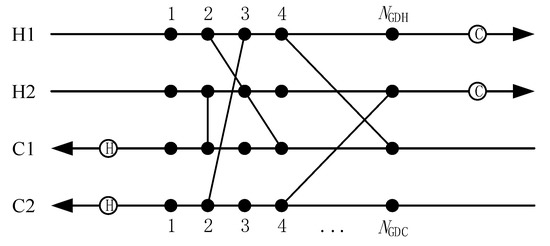
Figure 1.
Sketch of the non-structural model.
In Figure 1, H1 and H2 represent two hot streams, C1 and C2 represent two cold streams, and the utilities are placed at the end of the hot and cold streams; NGDC and NGDH denote the positions of the heat exchangers present on each of the hot and cold streams, respectively.
Objective Function
This work considers a non-structural model of a HEN using the minimum TAC as a target. The mathematical description of HENs using the non-structural model is as follows.
The non-structural model consists of NH hot streams and NC cold streams. There are NKH nodes on the hot streams and NKC nodes on the cold streams, where NKH = NHNGDH and NKC = NCNGDC. The minimal TAC is calculated according to Equations (1) and (2).
where FG represents the fixed investment cost, CA represents the area cost coefficient of the heat exchanger; A represents the equipment area in m2; β represents the area cost index; Q represents the utility exchanger heat load in kW; C represents the cost coefficient; the subscripts CU and HU indicate cold and hot utilities, respectively; z, i, and j represent the heat exchanger number, hot stream number, and cold stream number, respectively; zNh,c, iNH, and j NC, where Nh,c represents the number of all heat exchangers that may exist and Nh,c′ represents the actual number of heat exchangers; finally, C′ represents the 0–1 binary variable indicating the existence of a heat exchanger.
The relationship between the heat loads and the heat transfer area of a heat exchanger is given by:
where h is the node on the hot stream, and c is the node on the cold stream; Tin and Tout are the inlet and outlet temperatures in °C, respectively; FCp,i is the heat capacity of the ith hot stream in kW/°C; FCp,j is the heat capacity flow rate of the jth cold stream in kW/°C; Ki,j is the overall heat transfer coefficient (kW/(m2°C)) of the heat exchanger generated by matching a node on the ith hot stream with a node on the jth cold stream; LMTDh,c is the logarithmic mean temperature difference between the hot and cold streams, which is calculated by:
In particular, when Thin − Tcout = Thout − Tcin, the arithmetic mean temperature difference can be used instead of the logarithmic mean temperature difference; thus Equation (5) can be rewritten as:
3. Improved RWCE Optimized HEN
3.1. RWCE Principle
The basic idea of the RWCE [17] is to generate the initial HEN structure randomly, take the reduction of the TAC as a direction of the compulsive evolution, and change randomly the heat duty of the heat exchanger. This is done to achieve the simultaneous optimization of continuous variables and integer variables. When a local optimal value is obtained, the weak solution is randomly accepted with a certain probability to skip a local optimal solution and find the better optimal solution. The main steps are as follows.
(1) Random initialization
The initial population M, which includes n individuals Zi, i = 1, 2, 3, …, n, where each individual corresponds to a HEN structure, is randomly generated. The initial population is expressed as follows:
where Qh,c represents the heat load of the heat exchanger generated by a node h on the hot stream and a node c on the cold stream, and h = 1, 2, ..., NHNGDH, c = 1, 2, ..., NCNGDC; HM represents the number of nodes on the hot stream, and CM represents the number of nodes on the cold stream.
(2) Evolutionary stage
a. Random walking evolution of each individual in the population: The individual whose heat load is larger than zero is evaluated, and the random walking evolution for the individuals in the population is controlled by means of the evolution probability. This is written as follows:
where it is the iteration number; Qh,c is the initial heat load of an individual at the current iteration; ΔQh,c is the heat load change due to the walk; Qh,c′ is the heat load after the individual’s random walk; α and β are random numbers uniformly distributed between zero and one; 1–2αh,c indicates the walking direction of the individual; and ΔL represents the maximum walking step.
During the evolution process, the minimum heat load is taken as a critical criterion of the existence of the heat exchangers, and it is given by:
where η is the retention coefficient that refers to the ratio of the minimum heat load that can be retained to the maximum walking step ΔL.
b. Generation of new heat exchangers: A pair of nodes on the hot stream and another pair on the cold stream are randomly selected and checked to determine whether they match (a heat exchanger). If there is no matching between them, a heat exchanger with a certain heat load is randomly generated at a certain probability at the position given by:
where γ, γ1, and γ2 are random numbers uniformly distributed between zero and one; u is a node on the hot stream; v is a node on the cold stream; and Qp,q is the heat load of the newly generated heat exchanger at nodes u and v.
(3) Individual selection
If the TAC in the current iteration is lower than that of the previous iteration, the HEN structure of the current iteration is accepted, and the heat load and node number corresponding to the current structure are taken as the initial structure of the next iteration. If the TAC is not lower than that of the previous iteration, the HEN structure of the current iteration is accepted as the initial structure of the next iteration with a certain probability δ. The selection process is defined as follows:
where r is a random number uniformly distributed between zero and one.
(4) Termination criterion
The HEN structure with the lowest TAC in every iteration is recorded, and the iteration procedure is terminated when the following termination condition is satisfied:
3.2. Participatory Evolution Strategy for Streams
Compared with other optimization methods, the RWCE optimizes the HEN and can obtain a lower TAC. However, it requires a long computational time, and the optimization efficiency needs further improvement. According to a previous work [17], the existing heat exchangers are chosen randomly to participate in the evolution with a certain probability in each evolution process.
During the evolution process, the probability of participating in the evolution decreases at each iteration, which ensures that each evolving individual has a sufficiently high survival probability. Thus, there is no guarantee that each node on a stream will be selected to participate in the evolution during each evolution iteration. Considering the case of 13 hot and 7 cold streams, the node selection probability in the evolution process is set to 0.2, and the probability that each stream is not selected for each evolution is analyzed.
Figure 2 shows the relationship between the evolution probability and the number of heat units. As shown in Figure 2, in the early stages of evolution, the number of heat exchangers fluctuates significantly, and the probability of the selected streams varies. In the later stages of evolution, the number of heat exchangers is basically constant. At this time, the probability that each stream is not selected is fixed at about 0.74. For instance, in the case study considering 13 hot and 7 cold streams, in the later stages of evolution, approximately only three streams out of the 13 hot streams can be selected for evolution, while the remaining streams do not participate in the current iteration. Therefore, this iteration has no significance for a stream that has no heat exchanger selected for the current evolution. This approach requires a large number of iterations to ensure that each stream evolves once, which reduces the evolutionary efficiency. In view of this limitation, this study adopts a participatory evolutionary strategy for streams based on hot streams. The proposed strategy takes adequate measures to ensure that at least one heat exchanger on each stream is selected to participate in the evolution in a certain period. The proposed strategy ensures that each stream has a sufficiently high opportunity to participate in the evolution and improves the evolutionary efficiency of the algorithm.
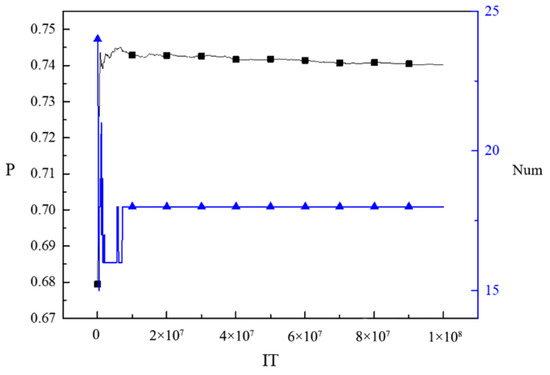
Figure 2.
Probability of a stream not being selected in an iteration.
The main strategy is to take measures in the evolution of the existing matches. Before an individual evolves, the number of heat exchangers already present on each stream is identified. Renumbering is then performed for the existing heat exchangers, and the new numbers are in a one-to-one correspondence with the original numbers. After every ITG1 iteration, adequate measures are taken to ensure that one heat exchanger on each stream is selected to participate in the evolution; other iterations are randomly involved in the evolution with the original evolutionary probability. The algorithm can not only give the population a certain direction after the individual has evolved to a certain extent but can also keep the population in the original random evolution direction during other iterations. It also retains random characteristics after a chosen number of iterations. Furthermore, ITG1 denotes the number of iterations after which the participatory evolution strategy for streams should be performed.
In the following, we consider a case with 13 hot and 7 cold streams [16] (Case 1), whose flow parameters are listed in Table 1. The TAC curve of the proposed strategy under the parameters NGDH = 10, NGDC = 10, ΔL = 100, η = 0.2, δ = 0.01, Qmax = 100, and ITG1 = 1000 is shown in Figure 3.

Table 1.
Flow parameters of Case 1.
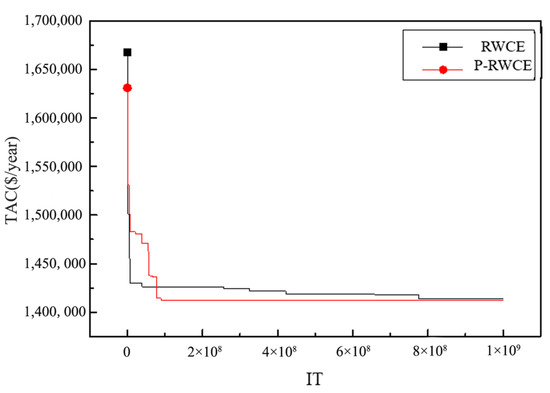
Figure 3.
TAC curve of the participatory evolution strategy for streams.
As shown in Figure 3, after adopting the proposed participatory evolution strategy for streams, a structure with a lower TAC can be obtained faster than when using the original RWCE. Thus, the proposed strategy can effectively improve the optimization efficiency and optimization quality of the algorithm.
3.3. Participatory Evolutionary Strategy Based on Hot Streams
When optimizing HENs using the basic RWCE, it has been found that the basic RWCE only takes evolutionary measures of the current individuals without guaranteeing that individuals will be accepted after each evolution. However, after adopting the proposed participatory evolutionary strategy, the heat loads of the heat exchangers on each stream change. Nonetheless, the cost of the current iteration cannot be guaranteed to be lower than the cost of the previous iteration. In most cases, if the structure cost of the current iteration is higher than that of the previous iteration, the current structure will not be accepted. Therefore, the participatory evolutionary strategy can change the evolution direction only to a certain extent but cannot avoid a local optimum. Accordingly, to fully exploit the role of the direction guiding of the participatory evolutionary strategy, further measures are taken for an individual’s selection, and the structure after a mandatory move by the proposed strategy every ITG2 iterations, where ITG2 denotes the number of iterations after which the structure that is obtained through the proposed strategy is accepted.
The participatory evolutionary strategy is performed periodically so that the HEN optimization can not only retain random characteristics of the original evolution method but also give a certain direction to the random evolution method and rapidly find a structure with a lower TAC. The RWCE with the participatory evolutionary strategy is used for optimization in two case studies. The flow parameters of Case 2 are listed in Table 2. The timely solution TAC curve and the best TAC curve obtained through the participatory evolutionary strategy are shown in Figure 4, while the comparison between the strategy and the original RWCE is shown in Figure 5. YCX in these figures represent the original RWCE.

Table 2.
Flow parameters of Case 2.
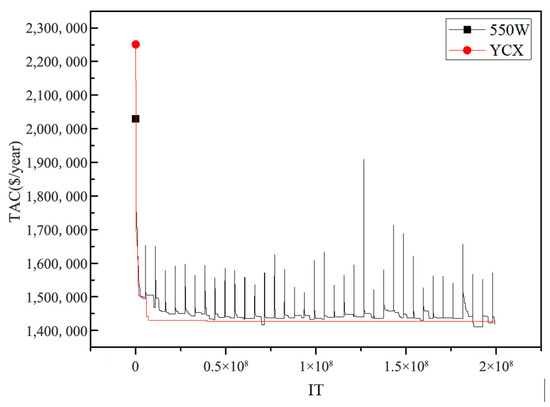
Figure 4.
Timely TAC curve and the best TAC curve obtained through the participatory evolutionary strategy.
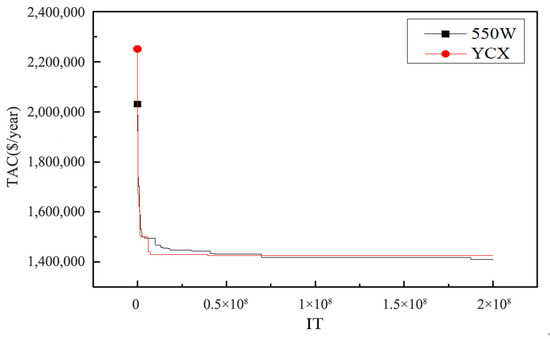
Figure 5.
TAC curve of each stream evolution strategy and TAC curve of the original algorithm for Case 1.
The TAC curves of the participatory evolutionary strategy and of the original RWCE for Case 2 are shown Figure 6 and Figure 7, respectively.
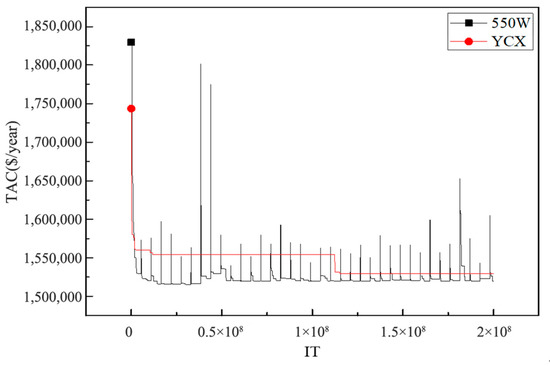
Figure 6.
Timely TAC curve of the participatory evolutionary strategy for Case 2.
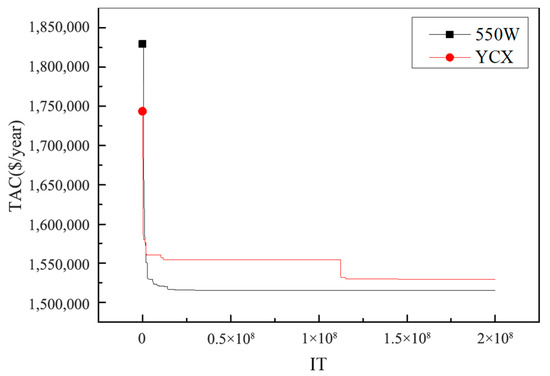
Figure 7.
TAC curve of the participatory evolutionary strategy and TAC curve of original algorithm for Case 2.
As shown in Figure 7, the RWCE adopting the participatory evolutionary strategy for streams can provide a better solution, which can significantly improve the solution efficiency and performance of the standard RWCE. In the participatory evolutionary strategy for streams y, the TAC increases sharply after the forced structure acceptance. However, every time the TAC increases, the original evolution direction is changed, and the local optimal value is discarded, thus enhancing the global search ability of the RWCE.
3.4. Weighted Evolution Strategy
Based on the presented TAC curves of the participatory evolutionary strategy for streams, a lower TAC of the HEN structure can be obtained more rapidly after adopting the proposed strategy. However, the algorithm is prone to premature convergence in the later optimization stages, and it is difficult for it to avoid a local optimum and find a better HEN structure. Therefore, this study analyzes the variation in the individual heat loads for streams without utility exchangers in the later stages of the HEN evolution.
As shown in Figure 8 and Figure 9, the energy that can be recycled for each stream is fixed. In the early evolution stages, the number of heat exchangers is variable, even if there is no utility exchanger on the stream. In the later evolution stages, the number and the heat loads of the heat exchangers on the streams without utility exchangers remain almost constant. Therefore, to avoid unnecessary iteration steps in the later evolution stages and to improve the evolution efficiency, a weighted evolution strategy is proposed. That is, after the number of iterations in the later stages of the evolution exceeds ITGZ, certain measures are taken on the evolution of the existing individuals to identify the streams without utility exchangers. After each ITG3 iteration, the streams without utility exchangers do not participate in the evolution, while the remaining streams are involved in the evolution with the participatory evolutionary strategy for streams, which forces the structure to be accepted after the current iteration. Furthermore, ITG3 is set to be a multiple of ITG2 so as to retain the algorithm ability to avoid falling into local optimums and prevent unnecessary evolutionary steps to a certain extent as well as achieve a strong global optimization ability.
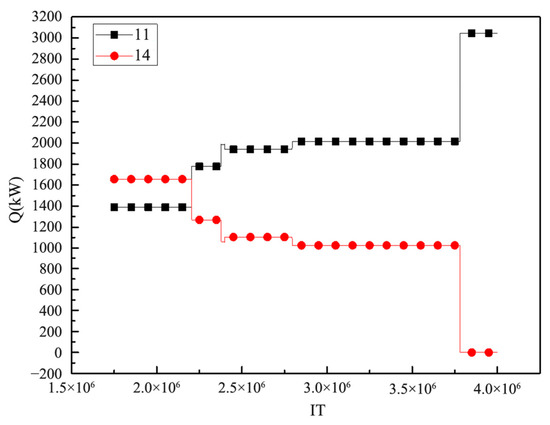
Figure 8.
Heat load change of the heat exchanger on the stream without a utility exchanger.
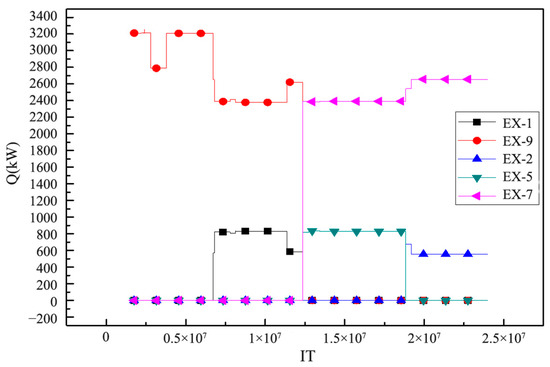
Figure 9.
Heat load change of the heat exchanger on the stream without a utility exchanger.
3.5. Improved RWCE by the Proposed Strategies
The improved RWCE combined with the above-described strategies is applied to the HEN synthesis. The evolution steps of the existing matches are as follows:
Step 1: Determine the position of the existing heat exchanger, renumber the existing heat exchanger, and establish a one-to-one relationship with the original node number of the exchanger;
Step 2: In the later evolution stages, evaluate the streams without utility exchangers when the number of iterations exceeds ITGZ;
Step 3: Allow random walks for all individuals within the population:
a. In the early evolution stages, every time ITG2 is iterated, at least one heat exchanger per stream is selected to participate in the walk. In the remaining iterations, normal random walking is performed according to the original probability.
b. In the later evolution stages, every time ITG3 iterates, a stream with no utility exchanger does not walk, and for the remaining streams certain measures are taken to select at least one heat exchanger per stream to participate in the walk. In the other iterations, random walking continues according to the original probability.
The improved steps of the individual selection are as follows:
Step 1: In the current iteration (it), if the TAC is not lower than that of the previous iteration, the HEN structure and the heat load of each node are accepted; the heat load of the structure is taken as the initial heat duty for iteration (it + 1) as follows:
Step 2: In the subsequent iterations, the algorithm continues searching for a lower TAC through the basic random walk operation. In the current iteration (it), if the TAC is lower than that in the previous iteration, the structure of the HEN and the heat loads of each node are accepted, and the structure is taken as the initial topology for the iteration (it + 1). Otherwise, the best individual is not updated, and the structure of the HEN and the heat loads of the former iteration are maintained, according to:
Step 3: If in the current iteration (it) the TAC is not lower than the network cost in the previous iteration, the structure of the HEN and the heat loads of the exchangers are accepted with a certain probability δ as the initial structure and initial heat loads for the iteration (it + 1). The specific operation is as follows:
where r is a random number uniformly distributed between zero and one; δ is the probability of updating the HEN structure and accepting a different solution when the TAC in iteration (it + 1) is larger than that in iteration (it). The specific flowchart is shown in Figure 10.

Figure 10.
(a) Flowchart of the weighted evolutionary strategy. (b) Random walk evolution for each individual in the population. (c) Individual selection.
4. Case Study Verification
4.1. Case 1
Most of the optimization methods presented in the literature are based on the stage-wise superstructure model proposed by Yee et al. (1990) [19,20]. Escobar et al. [21] used the isothermal mixing hypothesis, and the TAC was 1,537,086 USD/year. Pavão et al. [22] used the improved particle swarm optimization algorithm to obtain a TAC of 1,516,482 USD/year. Bao et al. [23] used the RWCE with an optimum protection strategy for the best topologies and obtained a TAC of 1,462,363 USD/year. In this study, the RWCE with the participatory evolutionary strategy for streams is used; the TAC is 1,432,904 USD/year, and the corresponding structure is shown in Figure 11. Using the participatory evolutionary strategy for streams, the obtained TAC value is 1,411,131 USD/year, and the structure with this TAC is shown in Figure 12. The results for Case 1 are shown in Table 3 along with other results taken from the literature for the same case study.
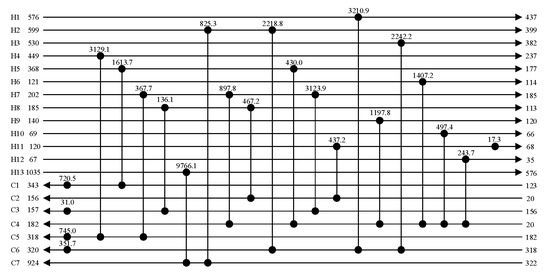
Figure 11.
Result obtained through the original RWCE.
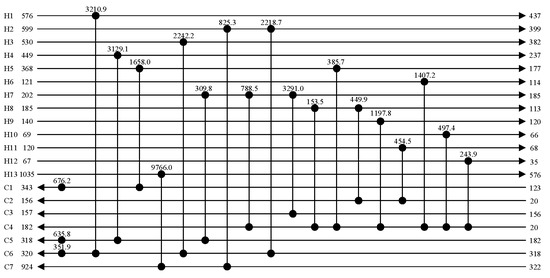
Figure 12.
RWCE optimization results of the participatory evolutionary strategy for streams.

Table 3.
Comparison of the optimized results for Case 1.
Comparing the solutions of Figure 11, Figure 12 and Figure 13, it can be observed that, when using the participatory evolution strategy, the utilities on H11 and C3 are eliminated, which makes the TAC decrease to 21,773 USD/year. When adding the weighted evolution strategy to the RWCE, two heat exchangers matching on the H1 promote the TAC to decrease to 1,396,348 USD/year, and the result shown in Figure 13 is lower by 66,015 USD/year. The quantified data confirm the effectiveness of the proposed strategy.
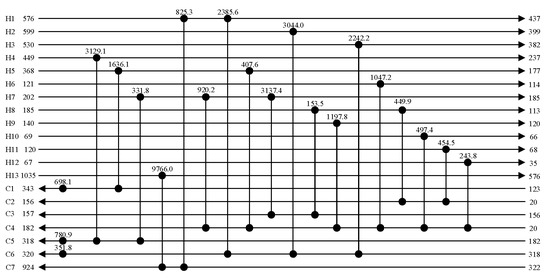
Figure 13.
RWCE optimization results using the weighted evolution strategy.
4.2. Case 2
The main characteristic of Case 2 is that the differences among the stream data induce a matching trend so that the final configurations are similar. Among the previous works, Bjork and Nordman [24] used the mathematical programming method to transform the HEN and obtained a TAC of 1,530,063 USD/year. Peng and Cui [25] used the modified simulated annealing algorithm and obtained a TAC of 1,527,240 USD/year. Pavão et al. [26] used a two-layer optimization method combining the simulated annealing algorithm and the particle swarm optimization algorithm and obtained a TAC of 1,525,394 USD/year. Recently, a combined algorithm was used by Pavão et al. [12] to solve this case. Their obtained TAC was 1,507,290 USD/year. In this study, when the original RWCE was used, a TAC of 1,519,791 USD/year was obtained, which is shown in Figure 14. After the participatory evolutionary strategy was added to the RWCE, the configuration changed. The number of heat exchangers matching on C1 changed from 2 to 1, the TAC decreased from 1,519,791 to 1,518,969 USD/year, and the specific configuration of the TAC is shown in Figure 15. Furthermore, when using the weighted evolution strategy, the cost is 1,511,549 USD/year for the structure shown in Figure 16.
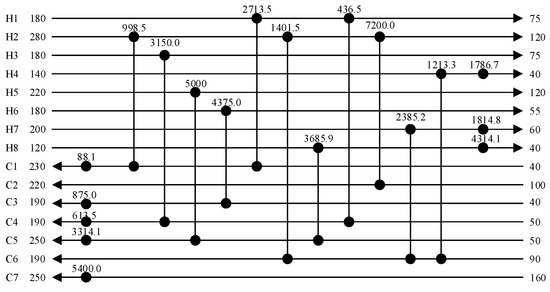
Figure 14.
Results obtained using the original RWCE.
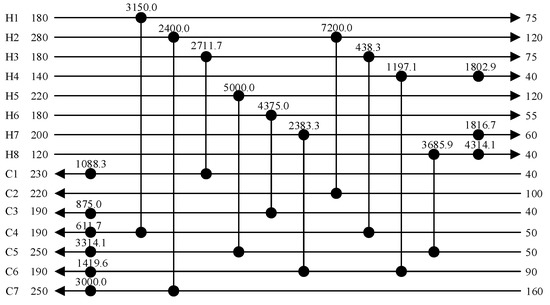
Figure 15.
RWCE optimization results of the participatory evolutionary strategy for streams.
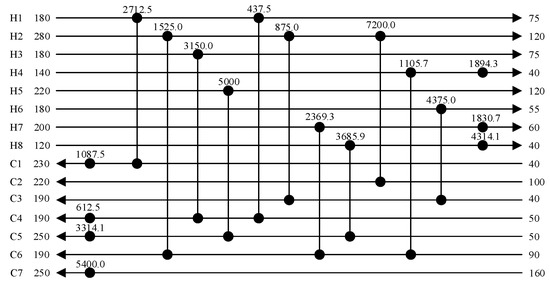
Figure 16.
RWCE optimization results using the weighted evolution strategy.
The optimization results and comparisons for Cases 1 and 2 show that the improved RWCE algorithm can obtain better results than other optimization methods under the same objective function, constraints, and cost coefficients. The proposed RWCE algorithm based on the participatory evolutionary strategy for streams and the weighted evolution strategy can be used to effectively improve the optimization efficiency and optimization quality of HENs.
5. Conclusions
The non-structural model considered in this work has strong freedom and flexibility. Thus, an improved RWCE with two novel strategies is proposed to increase the degrees of freedom of the non-structural model. The participatory evolutionary strategy enhanced the performance of the algorithm by giving a certain direction to the random evolution method, which is beneficial to find rapidly a structure with a lower TAC. Furthermore, the weighted evolution strategy is designed to avoid convergence in the later optimization stages. The combined strategies do not affect the freedom and flexibility of the non-structural model but enable a further optimization of the non-structural model to find better solutions more rapidly. The proposed strategy can achieve a lower TAC and a higher efficiency than other existing methods.
Author Contributions
Conceptualization, G.C.; Methodology, J.L., H.K.; Visualization, J.C.; writing—original draft preparation, M.C. All authors have read and agreed to the published version of the manuscript.
Funding
This research was funded by National Natural Science Foundation of China, grant number 51176125, 21978171, and 51976126 and Capacity Building Plan for some Non-military Universities and Colleges of the Shanghai Scientific Committee, grant number 16060502600.
Institutional Review Board Statement
Not applicable.
Informed Consent Statement
Informed consent was obtained from all subjects involved in the study.
Conflicts of Interest
The authors declare no conflict of interest.
References
- Linnhoff, B.; Dunford, H.; Smith, R. Heat integration of distillation columns into overall processes. Chem. Eng. Sci. 1983, 38, 1175–1188. [Google Scholar] [CrossRef]
- Linnhoff, B.; Hindmarsh, E. The pinch design method for heat exchanger networks. Chem. Eng. Sci. 1983, 38, 745–763. [Google Scholar] [CrossRef]
- Premkumar, R.; Rangaiah, G.P. Retrofitting conventional column systems to dividing-wall columns. Chem. Eng. Res. Des. 2009, 87, 47–60. [Google Scholar] [CrossRef]
- Yee, T.F.; Grossmann, I.E. Simultaneous optimization models for heat integration–II. Heat exchanger network synthesis. Comput. Chem. Eng. 1990, 14, 1165–1184. [Google Scholar] [CrossRef]
- Morar, M.; Agachi, P.S. Review: Important contributions in development and improvement of the heat integration techniques. Comput. Chem. Eng. 2010, 34, 1171–1179. [Google Scholar] [CrossRef]
- Coleman, T.F.; Conn, A.R. On the Local Convergence of a Quasi-Newton Method for the Nonlinear Programming Problem. SIAM J. Numer. Anal. 1984, 21, 755–769. [Google Scholar] [CrossRef][Green Version]
- Roux, N.L.; Fitzgibbon, A.W. A fast natural Newton method. In Proceedings of the 27th International Conference on Machine Learning (ICML-10), Haifa, Israel, 21–24 June 2010; pp. 623–630. [Google Scholar]
- Schraudolph, N.N.; Yu, J.; Gunter, S. A stochastic quasi-newton method for online convex optimization. In Proceedings of the Artificial Intelligence and Statistics, San Juan, Puerto Rico, 21–24 March 2007. [Google Scholar]
- Tseng, P.; Yun, S. A coordinate gradient descent method for nonsmooth separable minimization. Math. Program. 2009, 117, 387–423. [Google Scholar] [CrossRef]
- Quesada, I.; Grossmann, I.E. Global optimization algorithm for heat exchanger networks. Ind. Eng. Chem. Res. 1993, 32, 487–499. [Google Scholar] [CrossRef]
- Aguitoni, M.C.; Pavão, L.V.; Ravagnani, M.A.d.S.S. Heat exchanger network synthesis combining Simulated Annealing and Differential Evolution. Energy 2019, 181, 654–664. [Google Scholar] [CrossRef]
- Pavão, L.V.; Costa, C.B.B.; Ravagnani, M.A.d.S.S.; Jimenez, L. Large-scale heat exchanger networks synthesis using simulated annealing and the novel rocket fireworks optimization. AIChE J. 2016, 63, 1582–1601. [Google Scholar] [CrossRef]
- Lin, B.; Miller, D.C. Solving heat exchanger network synthesis problems with Tabu Search. Comput. Chem. Eng. 2004, 28, 1451–1464. [Google Scholar] [CrossRef]
- Fang, D.J.; Cui, G.M. Global optimization of heat exchanger networks using differential evolution algorithm. CIESC J. 2013, 64, 3285–3290. [Google Scholar]
- Feyli, B.; Soltani, H.; Hajimohammadi, R.; Fallahi-Samberana, M.; Eyvazzadeha, A. A reliable approach for heat exchanger networks synthesis with stream splitting by coupling genetic algorithm with modified quasi-linear programming method. Chem. Eng. Sci. 2022, 248, 117140. [Google Scholar] [CrossRef]
- Silva, A.P.; Ravagnani, M.A.; Biscaia, E.C., Jr. Particle swarm optimization applied in retrofit of heat exchanger networks. Comput. Aided Chem. Eng. 2009, 27, 1035–1040. [Google Scholar]
- Xiao, Y.; Cui, G. A novel random walk algorithm with compulsive evolution for heat exchanger network synthesis. Appl. Therm. Eng. 2017, 115, 1118–1127. [Google Scholar] [CrossRef]
- Xu, Y.; Heri, A.K.; Xiao, Y.; Cui, G. A new nodes-based model for optimization of heat exchanger network synthesis. J. Therm. Sci. 2020, 30, 14–28. [Google Scholar] [CrossRef]
- Yee, T.F.; Grossman, I.E.; Kravanja, Z. Simultaneous optimization model for heat integration-I. Area and Energy Targeting and Modeling of Multi-Stream Exchangers. Comput. Chem. Eng. 1990, 14, 1151–1164. [Google Scholar] [CrossRef]
- Yee, T.F.; Grossman, I.E.; Kravanja, Z. Simultaneous optimization model for heat integration-III. Process and heat exchanger network synthesis. Comput. Chem. Eng. 1990, 14, 1185–1200. [Google Scholar] [CrossRef]
- Escobar, M.; Trierweiler, J.O. Optimal heat exchanger network synthesis: A case study comparison. Appl. Therm. Eng. 2013, 51, 801–826. [Google Scholar] [CrossRef]
- Pavão, L.V.; Costa, C.B.B. Automated heat exchanger network synthesis by using hybrid natural algorithms and parallel processing. Comput. Chem. Eng. 2016, 94, 370–386. [Google Scholar] [CrossRef]
- Bao, Z.; Cui, G.; Chen, J.; Sun, T.; Xiao, Y. A novel random walk algorithm with compulsive evolution combined with an optimum-protection strategy for heat exchanger network synthesis. Energy 2018, 152, 694–708. [Google Scholar] [CrossRef]
- Bjork, K.-M.; Nordman, R. Solving large-scale retrofit heat exchanger network synthesis problems with mathematical optimization methods. Chem. Eng. Process. Process Intensif. 2005, 44, 869–876. [Google Scholar] [CrossRef]
- Peng, F.; Cui, G. Efficient simultaneous synthesis for heat exchanger network with simulated annealing algorithm. Appl. Therm. Eng. 2015, 78, 136–149. [Google Scholar] [CrossRef]
- Pavão, L.V.; Costa, C.B.; Ravagnani, M.A. Heat Exchanger Network Synthesis without stream splits using parallelized and simplified simulated Annealing and Particle Swarm Optimization. Chem. Eng. Sci. 2017, 158, 96–107. [Google Scholar] [CrossRef]
Publisher’s Note: MDPI stays neutral with regard to jurisdictional claims in published maps and institutional affiliations. |
© 2021 by the authors. Licensee MDPI, Basel, Switzerland. This article is an open access article distributed under the terms and conditions of the Creative Commons Attribution (CC BY) license (https://creativecommons.org/licenses/by/4.0/).